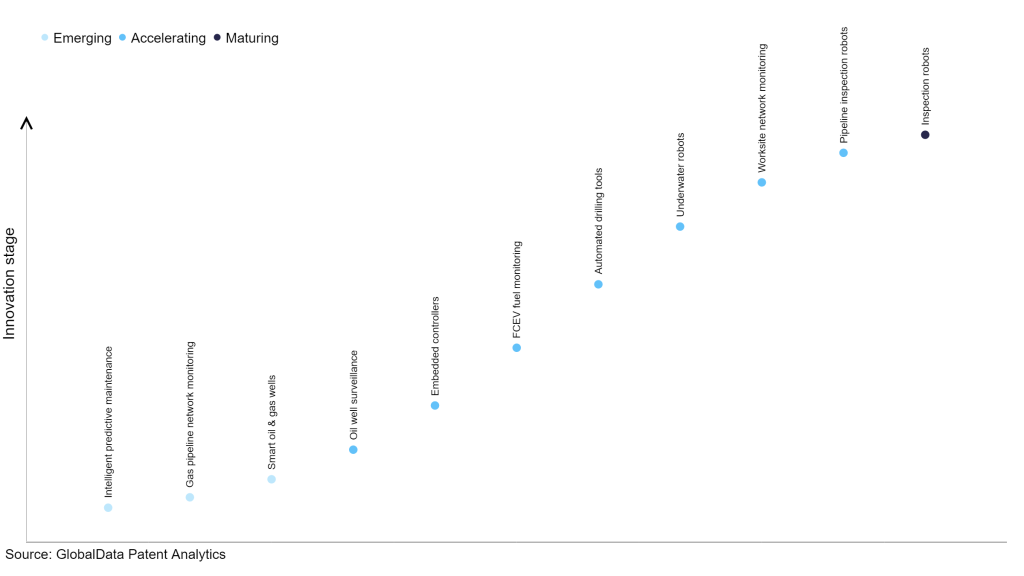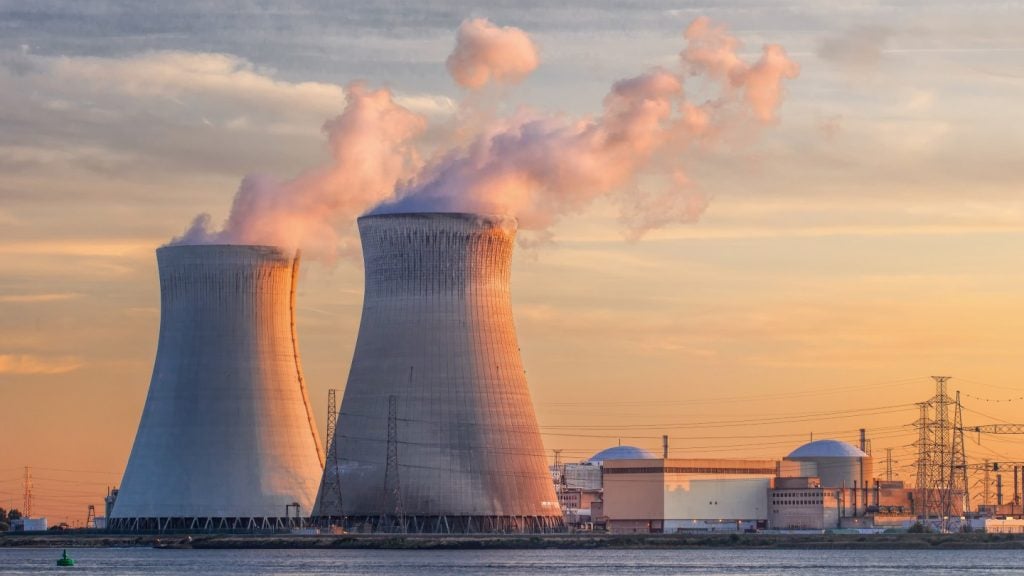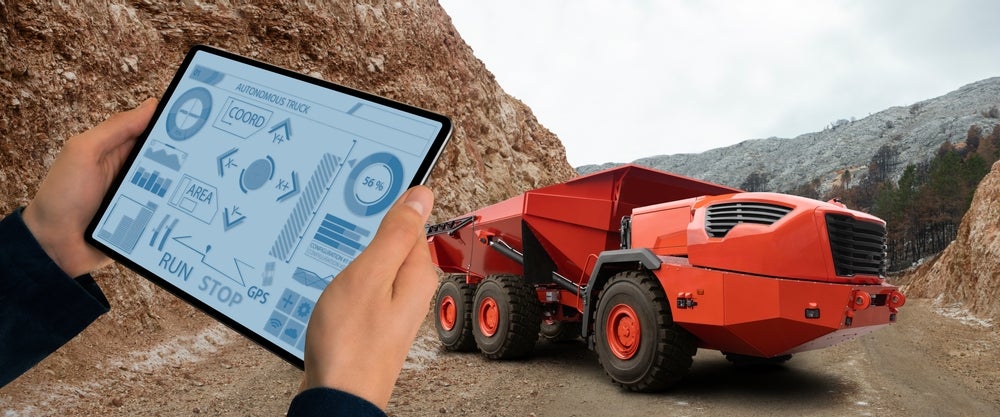The oil & gas industry continues to be a hotbed of patent innovation. Activity is driven by the need for efficient production, safety, cost control, and improving the long-term sustainability of operations. Digital technologies are playing a transformative role in meeting these objectives. This is characterized by the growing importance of technologies such as artificial intelligence, cloud computing, internet of things, and robotics, within the industry. In the last three years alone, there have been over 523,000 patents filed and granted in the oil & gas industry, according to GlobalData’s report on Internet of Things in oil & gas: inspection robots. Buy the report here.
However, not all innovations are equal and nor do they follow a constant upward trend. Instead, their evolution takes the form of an S-shaped curve that reflects their typical lifecycle from early emergence to accelerating adoption, before finally stabilizing and reaching maturity.
Identifying where a particular innovation is on this journey, especially those that are in the emerging and accelerating stages, is essential for understanding their current level of adoption and the likely future trajectory and impact they will have.
60+ innovations will shape the oil & gas industry
See Also:
According to GlobalData’s Technology Foresights, which plots the S-curve for the oil & gas industry using innovation intensity models built on over 196,000 patents, there are 60+ innovation areas that will shape the future of the industry.
Within the emerging innovation stage, intelligent predictive maintenance, gas pipeline network monitoring, and smart oil & gas wells are disruptive technologies that are in the early stages of application and should be tracked closely. Oil well surveillance, embedded controllers, and FCEV fuel monitoring are some of the accelerating innovation areas, where adoption has been steadily increasing. Among maturing innovation areas is inspection robots, which is now well established in the industry.
Innovation S-curve for Internet of Things in the oil & gas industry

Inspection robots is a key innovation area in Internet of Things
Remote inspection robots enable maintenance personnel to conduct asset inspections entirely from remote locations. They can deploy these robotic systems in different types of locations to perform numerous checks. These bots can operate with varying degrees of autonomy.
Inspection robots are primarily used in industrial settings where they assist the workforce in inspecting equipment to find faults or recover from outages. They can deliver a level of accuracy that humans cannot always provide and also improve worker safety, as inspection sometimes requires access to hazardous locations.
GlobalData’s analysis also uncovers the companies at the forefront of each innovation area and assesses the potential reach and impact of their patenting activity across different applications and geographies. According to GlobalData, there are 10+ companies, spanning technology vendors, established oil & gas companies, and up-and-coming start-ups engaged in the development and application of inspection robots.
Key players in inspection robots – a disruptive innovation in the oil & gas industry
‘Application diversity’ measures the number of applications identified for each patent. It broadly splits companies into either ‘niche’ or ‘diversified’ innovators.
‘Geographic reach’ refers to the number of countries each patent is registered in. It reflects the breadth of geographic application intended, ranging from ‘global’ to ‘local’.
Patent volumes related to inspection robots
| Company | Total patents (2010 - 2022) | Premium intelligence on the world's largest companies |
| Saudi Arabian Oil | 35 | Unlock Company Profile |
| Atlas Copco | 23 | Unlock Company Profile |
| Epiroc | 23 | Unlock Company Profile |
| Halliburton | 22 | Unlock Company Profile |
| iRobot | 11 | Unlock Company Profile |
| Baker Hughes | 10 | Unlock Company Profile |
| General Electric | 10 | Unlock Company Profile |
| Johnson Matthey | 7 | Unlock Company Profile |
| Rio Tinto | 6 | Unlock Company Profile |
| Oceaneering International | 3 | Unlock Company Profile |
| Chengdu Qinchuan Internet of Things Technology | 2 | Unlock Company Profile |
| Siemens | 1 | Unlock Company Profile |
| Shanghai Xpartner Robotics | 1 | Unlock Company Profile |
Source: GlobalData Patent Analytics
Leaders in IoT-enabled inspection robots for the oil and gas industry include Saudi Aramco, Atlas Copco, and Epiroc. Saudi Aramco’s in-house R&D team has developed several robots for the inspection and maintenance of its oil and gas assets. These robots are designed to provide inspection, surveillance, mapping, and emergency response services. The company has also developed the Shallow Water Inspection and Monitoring Robot (SWIM-R) for pipeline inspections. Furthermoer, it developed the Saudi Aramco Inspection Robot (SAIR), a magnetic robotic crawler capable of conducting visual inspection, ultrasonic thickness gauging, and gas sensing on hard-to-reach steel surfaces.
In terms of application diversity, Atlas Copco leads the pack, while Epiroc and Johnson Matthey stood in the second and third positions, respectively. By means of geographic reach, iRobot held the top position, followed by Atlas Copco and Johnson Matthey.
Oil and gas companies are increasingly using IoT-enabled robots for inspection to eliminate human intervention, increase accuracy, and improve the efficiency of operations.
To further understand the key themes and technologies disrupting the oil & gas industry, access GlobalData’s latest thematic research report on Internet of Things in Oil & Gas.
Premium Insights
From

The gold standard of business intelligence.
Blending expert knowledge with cutting-edge technology, GlobalData’s unrivalled proprietary data will enable you to decode what’s happening in your market. You can make better informed decisions and gain a future-proof advantage over your competitors.






